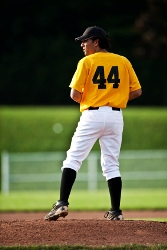One of the best ways to reduce the risk of overuse injuries for youth pitchers is to strictly observe per game, per week, per season and yearly pitch limits, whether mandatory (in the case of Little League Baseball's daily pitch limits) or recommended, as in those issued by USA Baseball1 and the National Athletic Trainers' Association.2
Studies show increased risk
In 2006, based on a study by the American Sports Medicine Institute in Birmingham, Alabama3 showing a strong link between the number of
pitches
thrown (both in a game and over the course of a season) and increased risk of arm injury, Little League Baseball announced that it was instituting pitch limits and mandatory rest periods between pitching
appearances. The rules, which became effective in 2007, were then updated for the 2010 spring season. 
At the time, Dr. James Andrews of ASMI, perhaps the world's foremost authority on pitching injuries, hailed the Little League pitch limit and rest rules as "one of the most important injury prevention steps ever initiated in youth baseball."
NATA pitch limit recommendations
Based largely on the findings of the 2006 ASMI study, the National Athletic Trainers' Association's 2011 position statement on overuse injuries,2 recently recommended the following general per game, per season and per year pitch limits:
- No more than 75 pitches per game for players 9 to 14 (90 pitches for pitchers between 15 and 18)
- Avoid competitive pitching more than 8 months a year
- Avoid pitching more than 600 pitches per season and 2000 to 3000 pitches per year (9- to 14-year olds)
- Pitchers between 15 and 18 years of age should throw no more than 90 pitches per game, and pitch no more than 2 games per week.
[For an article comparing the Little League Baseball and USA Baseball pitch limits, click here].
Travel ball wild card
While Little League Baseball rules now include a number of measures intended to ensure that its pitch limits are strictly followed, observing pitch limits represents a particular challenge where a youth baseball pitcher plays on independent travel and all-star teams competing in independently-operated tournaments because they may have NO rules at all on pitch limits and rest. The unregulated environment in which such so-called "travel ball" teams operate has led one critic to dub such teams the "Wild, Wild West" of youth baseball.
It thus may be up to parents to track their child's pitch counts so they don't exceed recommended limits, exposing them to the risk of serious elbow or shoulder injuries, such as a rupture of the ulnar collateral ligament (UCL) of the elbow requiring so-called Tommy John surgery.
Whether parents and coaches will heed the experts' advice, however, is problematic, given the hypercompetitive nature of today's youth baseball and a 2011 survey revealing an alarming lack of understanding by coaches, parents, and athletes about the relationship between pitch count and injury risk and misperceptions related to elbow UCL injury.
1. ASMI Position Statement for Youth Baseball Pitchers, August 2009.
2. Valovich McLeod TC, Decoster LC, Loud KJ, Micheli LJ, Parker JT, Sandrey MA, White C. National Athletic Trainers' Association Position Statement: Prevention of Pediatric Overuse Injuries. J Ath. Tr. 2011;46(2):206-220.
3. Olsen SJ 2nd, Fleisig GS, Dun S, Loftice J, Andrews JR. Risk factors for shoulder and elbow injuries in adolescent baseball pitchers. Am. J Sports Med. 2006;34(6):905-912.
Posted March 18, 2011








